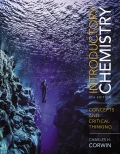
Concept explainers
(a)
Interpretation:
The two forms of energy that are involved during the conversion of water to steam by burning coal are to be stated.
Concept introduction:
Energy is the capacity to do work. The law of conservation of energy states that “energy can neither be created nor destroyed but it can be converted from one form to another.” The total energy of the universe is constant.
(b)
Interpretation:
The two forms of energy that are involved when steam drives a turbine are to be stated.
Concept introduction:
Energy is the capacity to do work. The law of conservation of energy states that “energy can neither be created nor destroyed but it can be converted from one form to another.” The total energy of the universe is constant.
(c)
Interpretation:
The two forms of energy that are involved when a turbine turns a generator are to be stated.
Concept introduction:
Energy is the capacity to do work. The law of conservation of energy states that “energy can neither be created nor destroyed but it can be converted from one form to another.” The total energy of the universe is constant.
(d)
Interpretation:
The two forms of energy that are involved when a generator makes electricity are to be stated.
Concept introduction:
Energy is the capacity to do work. The law of conservation of energy states that “energy can neither be created nor destroyed but it can be converted from one form to another.” The total energy of the universe is constant.
Want to see the full answer?
Check out a sample textbook solution
Chapter 3 Solutions
EBK INTRODUCTORY CHEMISTRY
- How much heat is required to raise the temperature of 100. grams of water from 25C near room temperature to 100.C its boiling point? The specific heat of water is approximately 4.2Jperg-K. a.3.2104J b.32J c.4.2104J d.76Jarrow_forwardaIs the process of boiling water exothermic or endothermic with respect to the water? bA charged object is moved closer to another object that has the same charge. The energy of the system changes. Is it a change in kinetic energy or potential energy? Is the energy changes an increase or a decrease?arrow_forwardBicycling Describe the energy conversions that occur when a bicyclist coasts down a long grade, then struggles to ascend a steep grade.arrow_forward
- Which of the following is the best example of potential energy changing to kinetic energy? a.Pushing a rock off a cliff. b.Sitting in a rocking chair. c.Observing a bird fly d.Standing on a tablearrow_forwardIn the following equation for a chemical reaction, the notation s, l, or g indicates whether the substance is in the solid, liquid, or gaseous state:2H2S(g)+3O2(g)2H20(g)+2SO2(g)+energy. Identify each of the following as a product or reactant: a SO2(g); b H2S(g); c O2(g); d H20(g). When the reaction takes place, is energy released or absorbed? Is the reaction endothermic or exothermic?arrow_forwardA particulate-level illustration of the reaction AB+CDAD+CB is shown below. a Identify the reactants and products in this reaction. b Is the change shown chemical or physical? c Is the mass of the product particles less than, equal to, or greater than the mass of the reactant particles? d If the reaction takes place in a container that allows no energy to enter or leave, how does the total energy in the container after the reaction compare with the total energy in the container before the reaction?arrow_forward
- How many joules of heat are lost by 3580 kg of granite asit cools from 41.2°C to -12.9°C? The specific heat ofgranite is 0.803J/(gC) .arrow_forwardA piece of iron was heated to 95.4C and dropped into a constant-pressure calorimeter containing 284 g of water at 32.2C. The final temperature of the water and iron was 51.9C. Assuming that the calorimeter itself absorbs a negligible amount of heat, what was the mass (in grams) of the piece of iron? The specific heat of iron is 0.449 J/(gC), and the specific heat of water is 4.18 J/(gC).arrow_forwardAntoine Lavoisier found that mass was conserved in chemical reactions when he saw thatarrow_forward
- (A) from the choices if both sentences are true (B) if both sentences are false (C) if the first sentence is true but the second is false (D) if the first sentence is false but the second is true.arrow_forwardImagine a container placed in a tub of water, as depicted inthe accompanying diagram. (a) If the contents of the containerare the system and heat is able to flow through thecontainer walls, what qualitative changes will occur in thetemperatures of the system and in its surroundings? From thesystem’s perspective, is the process exothermic or endothermic?(b) If neither the volume nor the pressure of the systemchanges during the process, how is the change in internal energyrelated to the change in enthalpy?arrow_forwardExpressing amounts of energy in different energy units is necessary to solve many chemistry problems. For practice, complete the following table. The Joule () is the SI unit of energy. 1 calorie (cal) = 4.184] 651 kJ 0.786 kcal 0.186arrow_forward
 Chemistry: The Molecular ScienceChemistryISBN:9781285199047Author:John W. Moore, Conrad L. StanitskiPublisher:Cengage LearningChemistry: Matter and ChangeChemistryISBN:9780078746376Author:Dinah Zike, Laurel Dingrando, Nicholas Hainen, Cheryl WistromPublisher:Glencoe/McGraw-Hill School Pub Co
Chemistry: The Molecular ScienceChemistryISBN:9781285199047Author:John W. Moore, Conrad L. StanitskiPublisher:Cengage LearningChemistry: Matter and ChangeChemistryISBN:9780078746376Author:Dinah Zike, Laurel Dingrando, Nicholas Hainen, Cheryl WistromPublisher:Glencoe/McGraw-Hill School Pub Co Chemistry for Today: General, Organic, and Bioche...ChemistryISBN:9781305960060Author:Spencer L. Seager, Michael R. Slabaugh, Maren S. HansenPublisher:Cengage Learning
Chemistry for Today: General, Organic, and Bioche...ChemistryISBN:9781305960060Author:Spencer L. Seager, Michael R. Slabaugh, Maren S. HansenPublisher:Cengage Learning General Chemistry - Standalone book (MindTap Cour...ChemistryISBN:9781305580343Author:Steven D. Gammon, Ebbing, Darrell Ebbing, Steven D., Darrell; Gammon, Darrell Ebbing; Steven D. Gammon, Darrell D.; Gammon, Ebbing; Steven D. Gammon; DarrellPublisher:Cengage Learning
General Chemistry - Standalone book (MindTap Cour...ChemistryISBN:9781305580343Author:Steven D. Gammon, Ebbing, Darrell Ebbing, Steven D., Darrell; Gammon, Darrell Ebbing; Steven D. Gammon, Darrell D.; Gammon, Ebbing; Steven D. Gammon; DarrellPublisher:Cengage Learning Chemistry & Chemical ReactivityChemistryISBN:9781337399074Author:John C. Kotz, Paul M. Treichel, John Townsend, David TreichelPublisher:Cengage Learning
Chemistry & Chemical ReactivityChemistryISBN:9781337399074Author:John C. Kotz, Paul M. Treichel, John Townsend, David TreichelPublisher:Cengage Learning





